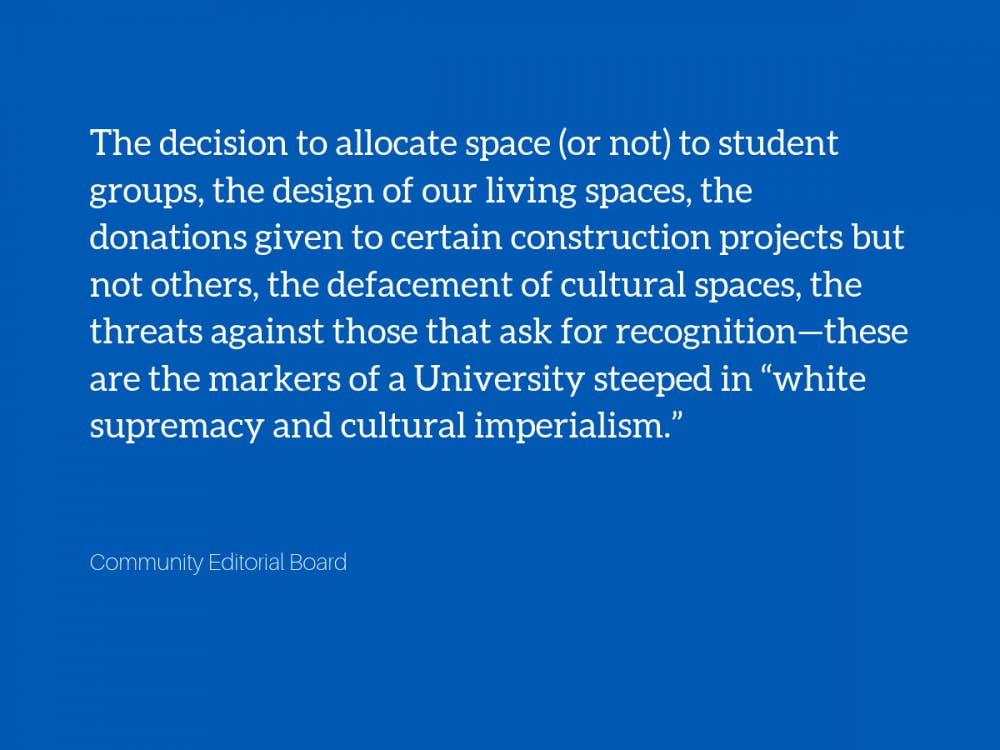The Community Editorial Board is fully independent of the editorial staff of The Chronicle.
Say, who are you that mumbles in the dark?
And who are you that draws your veil across the stars?
After two years of construction, Duke University will celebrate Sept. 28 the unveiling of the campus’ newest structure, the “state-of-the-art” Karsh Alumni and Visitors Center. Walk, run, or drive on Duke University Road or Campus Drive to view the 20,200 square-foot pavilion. Though ostensibly open to everyone—alumni, community members, students and staff alike—ultimately, this new structure is an alumni and visitor center, a $25 million suite of event spaces and offices. It may be open to the community at large, but it is not for the community, begging the question—where are the community spaces on campus? For whom are they built and where? And what, as a recent column asks, do these differential investments in spaces tell us about who is valued and cared for on this campus?
Our campus spaces, new and old, reflect the histories and values of the University. In front of the Duke Chapel stands an elevated, larger-than-life statue of James B. Duke, dedicated in 1935. The statue is located on what is now Abele Quad, the center of West Campus in front of the Duke Chapel. Julian Abele, the Black architect of West Campus, was recognized significantly only in 2016 with the renamed Quad and a commemorative plaque on the ground. This exemplifies the afterthought towards space for marginalized groups. The Center for Multicultural Affairs (CMA), a space “to think critically about diversity and social justice” is on the lowest level of the Bryan Center alongside La Casa, a space for Latinx students and the Asian American Pacific Islander Bridge for Action Solidarity and Education (AAPI BASE). The Hindu Students Association (HSA) shares a single prayer room in the basement of the Bryan Center Greenhouse with the Buddhist Community. The Student Disability Access Office (SDAO) is on Oregon Street, Central Campus where students no longer live and buses less frequently go.
Most of these community spaces for cultural and identity groups materialized as the result of advocacy and activism from students and supporting staff and faculty members. While some make efforts to create inclusive, welcoming spaces, others have chosen to uphold the exclusionary nature of the university. It has been just over a year since the Mary Lou Williams Center—a place made in contrast to other campus spaces by and for Black students—was vandalized. The past academic year saw its fair share of hate and bias incidents that have largely seen a lack of decisive action to address the issues. Just yesterday, Duke Student Government unanimously rejected the request from students to make Young Life, a Christian organization that explictly bars LGBTQ members from leadership positions, an official student group. This highlights how power is not just in the hands of administration, but also in the hands of students. Certain students will matriculate and enter the upper echelons of alumni, donors with the resources to make decisions and leave a legacy of how space is constructed on campus.
These gothic stones and immense glass walls don’t at first tell of white supremacy, ableism, or xenophobia. Their grandeur seems to say nothing of absence, until you look closer. The decision to allocate space (or not) to student groups, the design of our living spaces, the donations given to certain construction projects but not others, the defacement of cultural spaces, the threats against those that ask for recognition—these are the markers of a University steeped in “white supremacy and cultural imperialism.”
As we think about engaging with “violent, uncomfortable histories” we cannot forget the ways that those histories are present. They are intercalated in the physical geography, architectural landscape and administrative and campus decision-making processes. In this way, is necessary that we consider belonging grounded in, yet more than, location. We must, simultaneously, be actively moving to create a community that transcends physicality. How will we care for each other—within this campus and once we have moved beyond?
Editor's Note: This article has been updated to reflect DSG's vote rejecting Young Life as a campus organization.
Get The Chronicle straight to your inbox
Signup for our weekly newsletter. Cancel at any time.

